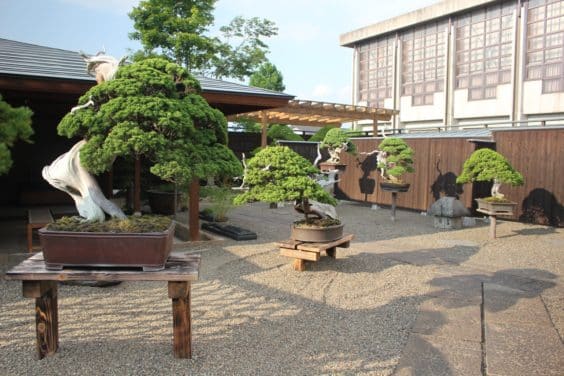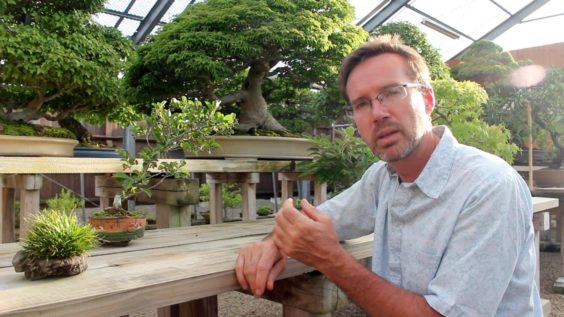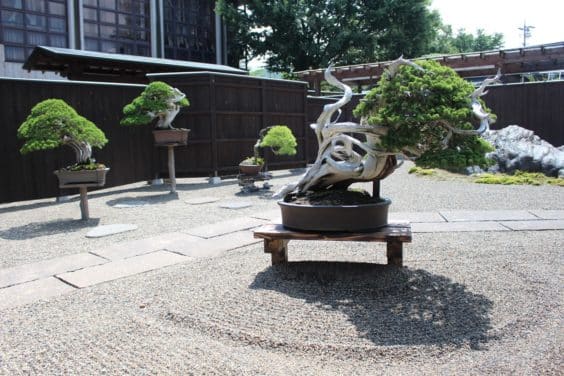The Bonsai Fundamentals Course is the latest installment from Bonsai Empire’s series of online courses. This course is hosted by instructor Michael Hagedorn and is filmed at Shinji Suzuki’s garden in Obuse, Japan.
For those who have yet to visit Suzuki’s garden, the course is a good opportunity to see what it looks like in summer. There are plenty of garden shots and ample close-ups of Suzuki’s prize-winning bonsai.
Conifers in Shinji Suzuki’s garden in Obuse, Japan
The course itself consists of 20 videos that cover plant physiology, Japanese aesthetics and design principles.
The unit on plant physiology provides an overview of how plants function in terms of hormones, photosynthesis and sugar movement. Upon completing the unit, my immediate reaction was to watch it again as Michael did a great job providing key insights that directly inform common bonsai practices.
From plant physiology, the topic shifts to Japanese aesthetics. Michael provides a brief introduction of terms like wabi, sabi, shibui and yuugen, among others.
I wasn’t sure, at first, how the seemingly diverse topics fit together, but all became clear in the course’s third section on design principles. It seems to me that the entire course is aimed at providing a holistic foundation for how to approach bonsai. Many seemingly arbitrary bonsai practices are soundly rooted in the physiology of how trees and shrubs grow. Likewise so many styling conventions.
Armed with this information and informed with some key concepts of Japanese aesthetics, we can begin to unlock the why behind so many bonsai practices.
Michael Hagedorn in Suzuki’s garden
Unlike so many beginner references, this course will likely provide at least some new information for enthusiasts of all levels.
Don’t, however, expect great detail on any of these topics. As the title indicates, the course provides bonsai fundamentals only. With a total runtime of under two hours, only so much detail is possible given the scope.
Bonus material includes a discussion with Shinji Suzuki and a tour of Michael’s Portland, Oregon, bonsai garden.
What, if anything, would I like to see included? Some form of written reference. Many of the topics covered are valuable enough that I’d like to refer to them from time to time. This might say more about my learning style than it does about the course, but it also speaks to how useful I found the information as I plan to incorporate a number of these topics into my teaching.
Shinji Suzuki’s bonsai garden
The course is available now from Bonsai Empire. To see a complete list of course topics and to register, go to the Bonsai Fundamentals Course.
Subscribe to Bonsai Tonight
New Posts Delivered Every Tuesday and Friday



Mac McAtee says
Jonas,
It is always good to review fundamentals no matter what stage of bonsai you consider yourself to have accomplished. And for that matter there is always new information coming forward that you won’t know about if you don’t go back and see what is being done currently. As well as getting ideas and opinions from all manner of experts helps you form an opinion of how you view a particular topic.
I took the course and fully agree with you about written content. It would be great if you could flip through a notebook to a particular topic in the course, then find the exact statements about one part of it, without having to run to the computer and sit through a video looking for what was said.
Bruce Harris says
Questions: What is the cost if any? Does it include providing copies of the 20 videos for those that sign up or is it watching the videos in a logical order? I apologize if I missed these details in your message. I believe they were contained in the Mirel three level offer from Ryan Neil.
Jonas says
Hi Bruce – the course is currently priced at 39.99 for unlimited online access to the course content. You can watch the videos in any order. If you are curious to get a feel for the course, the unit on water is available for free.